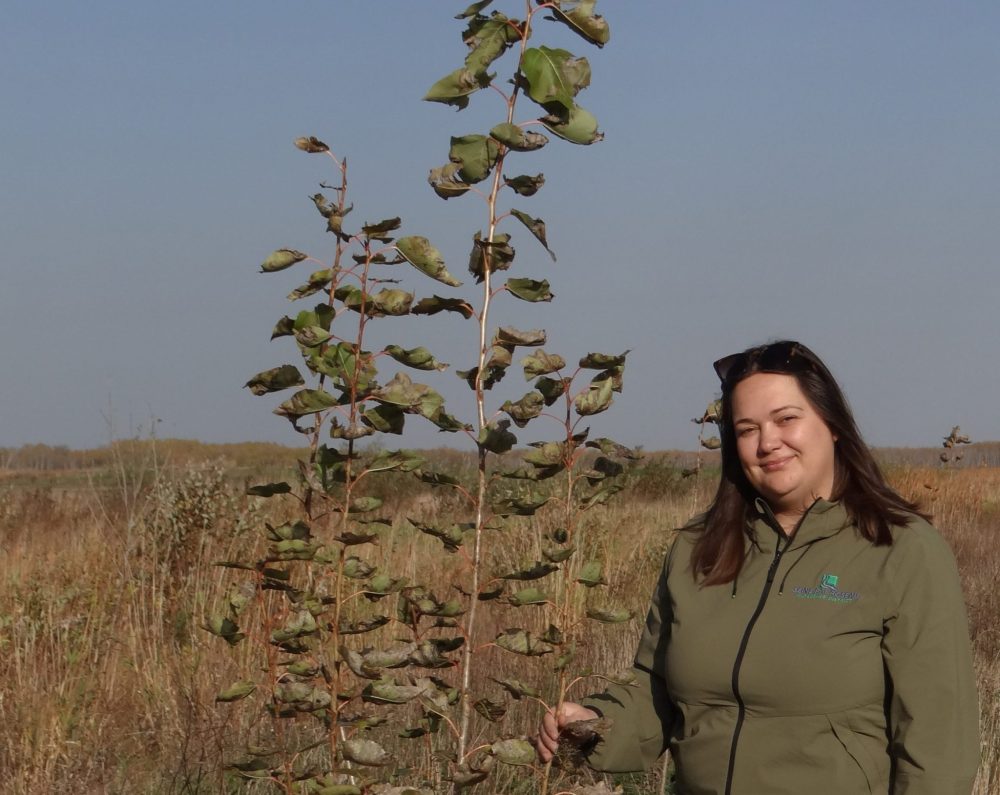Watershed projects good for organic crop producer
Advertisement
It has been years since the Prairie Farm Rehabilitation Administration discontinued the popular shelterbelt program in western Canada, but today the planting of shelterbelts is very much a part of the Seine Rat Roseau River Watershed District’s strategy aimed at the long term sustainable use and management of land and water resources.
The SRRWD shelterbelt program provides landowners funds to establish, or re-establish, shelterbelts to protect soil from wind erosion and to capture moisture. Funding is provided for trees and shrubs to be planted along creeks, around farmsteads, and in wide open spaces.
Dani Gosselin, during a tour of a project along a creek near Sarto, explains the benefits of shelterbelts for the land owner and the conservation district.

Shelterbelts not only protect soil from wind erosion, but also increase snow cover and provide wildlife habitat, she said.
This is the third year for the delivery of the shelterbelt program by the SRRWD. Shelterbelt projects eligible for funding must be on agricultural land or adjacent to the owner’s farmstead. Small projects and urban yards that just need a few trees, don’t fit into the program.
Most projects are in the range of three to five acres and Royden Loewen’s shelterbelt south of Sarto is one of the earlier ones, planted in 2022.
Gosselin talked about seven projects that are on the go this year. Three shelterbelts were planted this summer and three other sites are being prepped this fall with the planting trees to take place in spring. Spring plantings are slated for Friedensfeld, Aubigny, St Malo and Randolph.
Right now, Gosselin is lining up projects for next year. Approvals involve staff and board member visits to the site and their recommendations before a partnership advisory council and the main board of SRRWD makes the final decision.
Once approved, the landowner is responsible for the planting of the trees, or in the case of Loewen, hiring someone to do the planting. For Loewen’s project, involving both sides of a creek, running in a northerly direction, different species were selected. On the eastern side, Okanese poplars are interspersed with white spruce, alternating every 10 feet.
The west side has a row of willows, which will grow faster and provide thicker cover for the winds from the west.

This year was ideal growing weather, with mostly even rains for most areas, so it does not take long for the trees to find the moisture needed to root well.
For Loewen, the growing of a shelterbelt and buffer strips along the creek, which runs through his 700-acre farm, is just another way to improve the soil and help the environment. The reduction of soil erosion and the creation of wildlife habitat are equally important to Loewen.
“On the organic side, strips beside the shelterbelt, planted to something other than grass is great for a well-balanced ecology.”
At the farm south of Sarto, the strips on either side of the creek are 20 feet wide, which makes this shelterbelt a five acre project.
Loewen says a Saskatchewan company owned by a veterinarian enthusiastic about trees recommended the varieties he should plant. He hired a Morden company to do the planting, and it took them just three hours to create the mile-long shelterbelt, involving about 1,000 poplar, spruce and willows.
For years, Loewen has been planting cover crops on this field, which produces organic hemp and alfalfa. The field has 320 acres of organic hemp and 120 acres of certified organic alfalfa seed. The alfalfa seed is produced for a contract with an American company, while hemp goes to the hemp oil plant on Highway 75.
Loewen, who has been in organic crop production for eight years, is no stranger to the benefits of cover crops, which is another program the SRRWD promotes and funds.

Loewen says he has any number of reasons for growing cover crops. In addition to reducing soil erosion, growing anything also improves the soil and beautifies the land at the same time.
“Nothing is more attractive to a farmer than a green field.”
Loewen also admits he enjoys raising the eyebrows of the local farmers. He tells the story of being stopped by a farmer while he was seeding barley after the harvest one fall. Being so late in the growing season, the man wondered when Loewen planned to harvest his crop.
The man was dumbfounded when Loewen told him he planned to plow it under in the spring.
But Loewen says barley is an effective cover crop for him and it is so much less expensive than the cover-crop “cocktail” he tried a few years ago.
Loewen says they also use a lot of manure as fertilizer and pay its distribution on their 700-acre farm. Although that is expensive, it still is a lot cheaper than synthetic fertilizer, which of course is not an option, for this organic crop producer.
Planting cover crops and the establishment of shelterbelts are just two of the many programs eligible for funding in the 3,700 square kilometres that is the SRRWD.

The Seine Rat Roseau Watershed District, was established in partnership with local municipalities and the Province of Manitoba in 2001 to provide an avenue for local people to work together on issues related to sustainable land and water management.
The district includes an area of approximately 3,700 square kilometres in southeastern Manitoba and partners with a dozen rural municipalities, the Towns of Ste. Anne and Niverville, the Village of St. Pierre-Jolys and the City of Steinbach.
The SRRWD focuses its efforts on addressing locally identified land and water management issues. The District offers program funding in groundwater protection, riparian area management, water conservation, soil conservation, and surface water management.
The SRRWD also provides opportunities for watershed management education through school presentations and at their Tourond Creek Discovery Centre.
